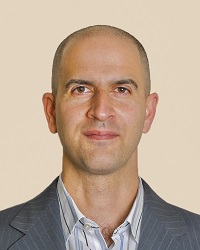Dr. Jacob Rullo is a SEAMO-funded clinician scientist in the Department of Ophthalmology, cross-appointed to the Departments of Biomedical and Molecular Sciences and Medicine, and, in addition to completing his residency at Queen’s, has been here since July 2020. Clinically, Dr. Rullo’s primary focus is neuro-ophthalmology, which deals with diseases of the eye-brain axis. “My other clinical hat revolves around emergency eye care, specifically being on-call for eye injuries, traumas and all cases of sudden vision loss,” he explains.
Medicine, and, in addition to completing his residency at Queen’s, has been here since July 2020. Clinically, Dr. Rullo’s primary focus is neuro-ophthalmology, which deals with diseases of the eye-brain axis. “My other clinical hat revolves around emergency eye care, specifically being on-call for eye injuries, traumas and all cases of sudden vision loss,” he explains.
Dr. Rullo is a translational basic scientist ophthalmologist, working towards understanding the inherent connections between the eye and the other parts of the body. “The eye is a compartmentalized structure, walled off from the rest of the body. Consequently, the compartments within the eye have a unique and local biology, which can be measured and analyzed. Generating information from these local tissues can drive important hypothesis generation about untreatable diseases,” Dr. Rullo enthuses. He continues to say, “Using clinically-derived samples from the tissue, we can make inferences about important molecules that we can test in animal models of diseases with the hope of uncovering novel ideas for drug development. The Holy Grail of Ophthalmology is to protect the retina and optic nerve. These structures generate and transmit vision stimuli to the brain. It is an information highway! Unfortunately, they suffer the same fate as other central nervous system structures; once injured, permeant damage ensues. In the eye, we have a unique opportunity to treat these inaccessible structures without having to go through the blood and deal with systemic effects on the body. What we want to do is manipulate the eye’s unique internal environment and make new discoveries to have the greatest therapeutic impact.”
Dr. Rullo explains: “The other part of my research focuses on the importance of the eye being situated outside the body. It is the only mucosal membrane truly exposed to the outside world. The eyes’ surface is externalized and is in constant exposure to microbes. One theory I had early in the COVID-19 pandemic was that the eye sees SARS-CoV-2 very early yet avoids becoming infected. The eye then transmits these viral particles to the upper respiratory tract, therefore providing a form of immune “education” required for long lasting immunity. Taking this one step further, if the eye is an important microbial transfer site, perhaps we could take advantage of this to develop a topical vaccine administered through the eyes. By virtue of being at the ‘top’ of the respiratory tract, this would cover all the at-risk downstream sites. Interestingly, baby chickens are in fact vaccinated against respiratory viruses through a topical eye drop. The question we are now working towards answering is whether this is possible. So far, our animal studies have shown a very interesting relationship between the eye, nose, lymph nodes and lungs with respect to a local and distant immune response. It is very preliminary, but exposure to the eye first seems to have a protective benefit in terms of preventing severe disease. Additional research will now dissect these findings.”
Dr. Rullo, showing his passion for the field, says, “The real beauty in Ophthalmology is how one glance into the eye can tell you about the entire body. The reason I went into Ophthalmology is because it’s intricately linked to the vascular, hormonal and central nervous systems. We have the ability to connect the eye to the body as a whole in order to better treat diseases such as diabetes, hypertension, impending strokes and even potentially have an impact on cancer care. It’s one of the unique areas in medicine where you can see and touch in real-time without any need for a specialized test. This excites me! As the cliché goes, the eyes are a window into your body.”
In terms of what he wants the future to bring, Dr. Rullo hopes clinician scientists can be integrated as fundamental members of the core science Departments. He emphasizes, “My job is not only to be the clinician scientist who understands both medicine and science in parallel, but to be the person who can actually bridge both worlds together. In Ophthalmology, clinician scientists are uncommon. We need to do better in Canada to create these positions and attract individuals with a unique lens for discovery that ultimately leads to better patient care.”
